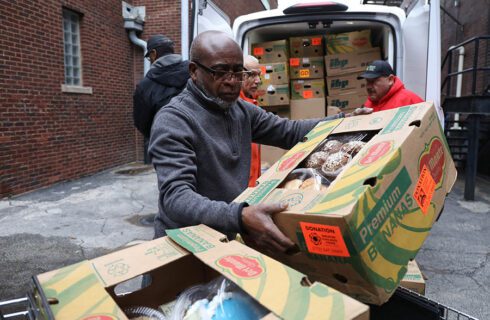Ramona Rodriguez is a first-time mom.
Her son, Adrian, is just over a year old. They live with Rodriguez’s sister and brother-in-law in Chicago’s Jefferson Park neighborhood.
She’s grateful to have the extra support of her family as she raises her son. It can be challenging, Rodriguez said, because she had to stop working in order to care for him. She used to work two jobs. Her local daycare, she explained, won’t enroll him until he’s older.
“They give me a lot of support,” she said of her family.
Rodriguez has also been turning to the New Hope Community Food Pantry. Adrian, she mentioned, likes the fruit and string cheese they pick up from the pantry.
“They give me diapers, wipes, baby food – this is a big help,” she said.

Volunteers at New Hope Community Food Pantry hand food to guests in its drive-up lane. The pantry has distributed outdoors since the start of COVID.
Rodriguez’ family is just one of the hundreds across the city’s Northwest Side visiting New Hope in times of need. With a recent move into a larger facility, the pantry’s workers are aiming to improve the experience for the rising number of families turning to them for help.
Settling into new space
“This has been a fabulous move for us,” Donna Oberhardt, the pantry’s coordinator, said during a recent distribution.
For nearly 20 years, New Hope operated out of a church on West Hood Avenue in Old Norwood Park. Oberhardt described it was a “rabbit warren” of a space: small rooms, lots of stairs, and not enough storage.

New Hope's old space (pictured here) had limited storage and walking space (photo courtesy Donna Oberhardt).
“We always seemed to be on top of each other,” she said. This was especially troublesome once the COVID-19 pandemic hit. She and the other volunteers moved the distributions outdoors in order to socially distance.
This past January, New Hope moved to its new location in Jefferson Park – the gymnasium at The Branch Community Church on West Foster Avenue. The site, which pantry leaders say is more centrally located to the zip codes it serves on the city’s Northwest Side, gives the pantry more breathing room. They will be able to return to an indoor, store-like model of distribution, after more than two years of drive-through and walk-ups. Oberhardt is hoping to make the switch back this summer.

New Hope's new space in the Branch Community Church gymnasium. The pantry moved in January.
“They can take what they need as opposed to what we give them,” she said. “It’s just so much better.”
Rising prices, rising need
The expansion is well-timed. The pantry has been “exploding” with visitors lately, according to Oberhardt. The team has been serving around 200 households weekly.
Before the pandemic, New Hope used to serve an average of just 40-60 households. COVID inflated those numbers over the past couple years, but Oberhardt is guessing that inflation may be the cause of the recent spike in visitors.
“Nowadays with groceries so expensive, it’s just hard for average people to pay for it,” said Joshua, a newcomer to the pantry.
Joshua, 21, picked up food for himself as well as his mother, brother and newborn son. He has a job at a nearby warehouse and helps his mom with rent and bills. But with prices of food, gas and other necessities going up, the extra help is appreciated.
“It feels warm, it feels comforting,” Joshua said of having somewhere nearby he can turn for support. “Especially because I’m not the only one that’s struggling.”
Even in difficult times like this, Oberhardt said she never grows tired of being there for her neighbors. She’s been running the pantry since the early months of COVID, but had been volunteering for years prior.

Donna Oberhardt, the director of New Hope Community Food Pantry.
Being a helping hand is how she’s “wired.” Oberhardt, 61, grew up on a dairy farm outside of small town near Green Bay, Wisconsin. She recently retired after 25 years in Chicago Public Schools, most recently as a principal at the Edison Regional Gifted Center just a few miles down the road. This service role, she said is a natural extension of her teaching career.
“It feels remarkably rewarding,” she said. “This is 10 times more work than we ever had before. But it’s good work.”
Share This Post




